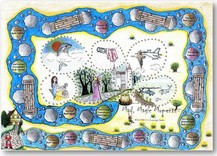Board Game Basics

Board Game Basics: Board games are an excellent means of teaching language arts, communication and early math skills to young children.
But what are board games and how do we define them?
Board Game Basics: A Definition
Board Games have a central board that a player's position can be tracked in relation to other players. Board
games often have tokens or avatars that represent the player. For example, the racing car or the hat tokens in Monopoly,
and tokens used to represent a player's position in Snakes and Ladders.
Board Game Basics: The Main Types of Board Games
As a general rule, board games can be divided into three categories: war games, race games and alignment games.
- In war games, the main purpose is to defeat or destroy your opponent. Examples include, chess, checkers, and Go.
- Race games involve a number of players attempting to reach a goal or destination first. Snakes and Ladders, Monopoly, Scrabble,
Pictionary are all race games.
- Alignment games are board games which require players to place their pieces on a game board to reach a particular configuration. In contrast to race games, alignment games require the player to strategically position pieces on a board rather than position pieces across a board to reach a destination.
Board games contain specific rules. That is, board games have a specific set of rules that, for instance, limit the amount of players that a game can have, the number of spaces on a board, the number of possible moves and the limits of what can be done in a particular move.
Games of skill, in contrast to board games, generally don't have the same limits imposed on players. The number of moves and positions in games of skill are more open-ended, and can be endless.
Many board games use dice and/or playing cards that contain information that affects the outcome of the game. Dice in a board game generally relates to the movement of the tokens on the board.
Virtually all board games are turn based. Children's games, particularly for young children, are based on luck, on the roll of the dice.
Games for older children have decisions built into the games, which affect the outcome of games. For instance using a combination of letters
to create a particular word in scrabble.
Board games require two or more players, which contrasts with puzzles or video games which are generally solitary activities,
though there is the option of other people joining the game. Board games have the important aspect that they are social in nature
because they require players to interact meaningfully with other players.
As we can see, board games have a particular set of criteria which separate them from other forms of games. The key component of a classic board game is that it is fun and that it teaches important early learning skills.
References
Brathwaite, B & Schreiber, I (2009) Challenges for Game Designers: Non Digital Exercises for Video Games Designers Course Technology CENGAGE Learning
Hinebaugh, J.P. (2009) A Board Game Education: Building Skills for Academic Success Rowman and Littlefield Education
Return from Board Game Basics to Educational Board Games
Enjoy this page? Please pay it forward. Here's how...
Would you prefer to share this page with others by linking to it?
- Click on the HTML link code below.
- Copy and paste it, adding a note of your own, into your blog, a Web page, forums, a blog comment,
your Facebook account, or anywhere that someone would find this page valuable.
|